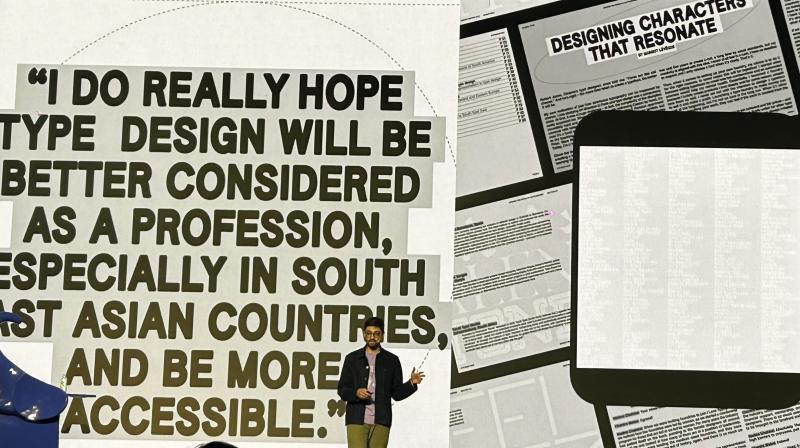Matt Alagiah, editor-in-chief, It's Nice That, opened the inaugural session of this year’s Kyoorius Designyatra in Goa with a keynote address.
This year at Designyatra, the theme is 'Academy of Play', where professors (speakers) are highlighting the importance of playfulness.
Alagiah’s talk delved into how designers, artists, and media publications should aim to tell more meaningful, human-led stories and, at the same time, commission work that financially supports underrepresented communities.
Media publications should support the creative community through commissions
Reflecting on the challenges faced by creatives during the pandemic, Alagiah noted, "We (his publication It's Nice That) worked pretty hard to support our creative community designers, illustrators, and photographers who helped us with our publication. Especially, when projects were cancelled, and plans disappeared. In particular, we collaborated with Dropbox to produce ‘Zine Z,’ which is all about the joys of indoor life. While it gently encouraged people to stay indoors, it also aimed to provide something fun to do during the long stages of the pandemic. But most importantly, it was about putting money into the pockets of creative talent. That mission often works quietly in the background of everything we do."
Diversity and inclusion in creative projects
He then went on to point out how media publications can increase diversity in the creative industry.
Alagiah shared, "We want to make a meaningful difference in the creative world, especially by increasing diversity. With every project, story, and commission, we’ve set a clear goal: to ensure that the creatives we’re collaborating with and writing about come from a wide range of backgrounds—often black, Asian, and minority ethnic groups. Over the past few years, we've also focused on socioeconomic backgrounds, gender diversity, and LGBTQIA+ representation. We aim to reflect the creative industry in its truest, most inclusive form, and ensure that our work leaves the right kind of mark on it."
Explaining his teams editorial process, he shared, "We often get asked, 'How do you choose what to write about?' Honestly, it's driven by what surprises us or makes us laugh. Our writers and editors are constantly on the lookout for inspiring creatives, and when we come together, we reflect on who we've met and which stories deserve to be shared. Whether it's an untold narrative, something unique, or simply humorous, we aim to offer insights that delve deeper into the workings of the creative industry."
AI in creativity: Opportunities and ethical considerations
Addressing the concerns surrounding AI in the creative community, he acknowledged the anxiety it has caused but emphasised that AI is here to stay and will continue to evolve. He stated that rather than resisting it, creatives need to learn how to leverage its potential to enhance their work.
He voiced, “With AI in the picture, the secret of good taste will be the currency of the future. While AI has sparked ethical debates, with concerns over its role in replicating creative tasks, 80% of designers are already using AI tools in some capacity. However, the assertion that while AI might handle the mechanics of design, it could never develop an artist's unique taste. Generative AI could be incorporated into a creative's existing styles, adding depth to the conversation about maintaining artistic integrity while embracing technological advancements.”
As AI technology continues to evolve, Alagiah addressed its potential to impact the creative process. “AI will make some tasks easier, like managing inboxes, taxes, or organising. But it also presents a challenge,” he said. "We need to move upstream, stop competing with tasks AI can already do, and focus on what sets us apart—creativity, storytelling, and the ability to come up with new ideas."
Impact of tighter budgets and competition on creativity
One of the more profound takeaways came from discussions around creative procrastination and burnout in the industry. The modern designer's reality often entails limited time and dwindling budgets. Yet, Alagiah noted, that the antidote lies in 'play'—a concept emphasised by neuroscientist Stuart Brown.
“Play not only fuels creativity but also enhances problem-solving and adaptability, crucial elements for creatives navigating today's fast-paced environment,” he remarked.
The DIY movement and the importance of creative side hustles
Alagiah left the audience with a clearer sense of the challenges ahead and how to embrace both technological and human advancements to shape the future of the creative world.
He shared, “We've become obsessed with productivity in the growth world, expecting our privileges to operate like a factory—always open, always producing. Creativity might be the only job left in the future. AI could lead to a new golden age for humanity, where we focus on the things we’re truly meant to do."
Despite concerns about AI amplifying productivity pressures, Alagiah sees a silver lining in the growing DIY movement.
"Capital forces are driving a rediscovery of craftsmanship and independence," he said. "Side projects, those that aren’t optimised for profit but for personal joy, are flourishing."
The advice for emerging creatives was clear: “Nurture your projects and passions. Side projects may seem niche or unscalable, but they’re where the real fun and innovation happen. And often, those personal pursuits will end up enhancing your professional work.”
In closing, Alagiah emphasised the importance of community in overcoming creative challenges. “Surrounding oneself with like-minded creatives is vital. It keeps you inspired, motivated, and continuously learning. We’re entering an era where the lines between work and play, professional and personal, are blurring. The most successful creatives will be the ones who embrace this flexibility, allowing AI to handle the mundane, while they invest their energy in what truly excites them,” he concluded.













